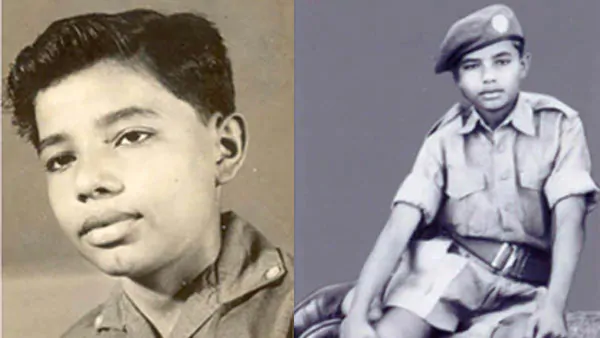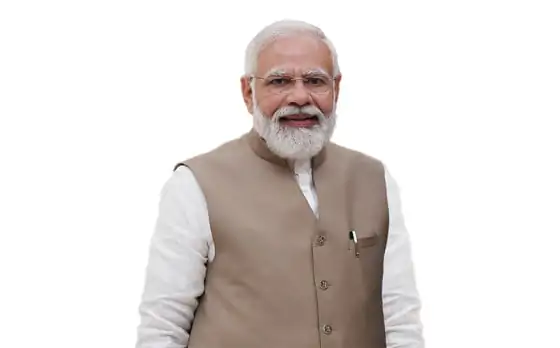Introduction: Narendra Modi
Narendra Modi, the 14th Prime Minister of India, is a name that resonates not only in the corridors of power but also in the hearts of millions across the globe. His life’s journey is a testament to the power of determination, leadership, and an unwavering commitment to the betterment of his nation. Born on September 17, 1950, in Vadnagar, a small town in Gujarat, India, Narendra Damodardas Modi’s life story is one of humble beginnings, perseverance, and a relentless pursuit of excellence.

Early Life and Education: Narendra Modi
Narendra Modi’s early life was marked by simplicity and hard work. He was born into a modest family, and his father, Damodardas Modi, ran a small tea stall at the Vadnagar railway station. Despite the financial constraints, young Narendra displayed a keen interest in academics and a determination to rise above his circumstances.
His education began at a local school in Vadnagar, where he showed an early aptitude for debate and public speaking. Teachers and classmates alike recognized his exceptional oratory skills. Narendra Modi’s love for reading and knowledge was evident from an early age, setting the stage for his future as a statesman and a thinker.
Modi’s journey continued through higher education at the University of Delhi, where he pursued a Bachelor of Arts degree. It was during this time that he became deeply involved in political and social activities, setting the stage for his remarkable political career. His association with the Akhil Bharatiya Vidyarthi Parishad (ABVP), the student wing of the Rashtriya Swayamsevak Sangh (RSS), marked his entry into the world of political activism.
G20 Summit 2023: Full Form, Theme, Logo, Date, and Latest Breaking News
A Remarkable Ascent in the RSS:
Narendra Modi’s association with the RSS proved to be a transformative phase in his life. He dedicated himself to the organization, adopting a disciplined and ascetic lifestyle. His dedication and leadership skills soon caught the attention of senior RSS leaders, who recognized his potential as a dynamic and committed activist.
Under the guidance of the RSS, Modi traveled extensively across India, gaining insights into the diverse cultural, social, and economic fabric of the nation. This exposure played a pivotal role in shaping his worldview and fostering a deep connection with the grassroots of India.
Modi’s journey within the RSS led him to various roles and responsibilities, including organizational work and training. His dedication and effective communication skills set him apart, and he rapidly rose through the ranks. His commitment to the ideology of Hindutva, a concept that emphasizes the cultural and spiritual unity of India, became a central tenet of his political philosophy.
Entry into Politics:
Narendra Modi’s foray into electoral politics was marked by his association with the Bharatiya Janata Party (BJP). In 1987, he joined the party and quickly established himself as a prominent leader in the Gujarat unit. His leadership skills and organizational acumen were evident during the 1990 Gujarat Assembly elections when the BJP improved its performance significantly under his guidance.
In 2001, when Gujarat faced one of the most devastating earthquakes in its history, Narendra Modi’s leadership during the crisis garnered widespread praise. His ability to manage the relief efforts efficiently and effectively showcased his administrative skills and earned him recognition as a capable leader.
Chief Minister of Gujarat:
In 2001, Narendra Modi was appointed as the Chief Minister of Gujarat, a position he would hold for an unprecedented four consecutive terms. His tenure as Chief Minister was marked by a series of ambitious reforms and development initiatives that would transform the state.
Economic Reforms and Development:
Modi’s economic policies and development agenda focused on attracting investment, promoting entrepreneurship, and ensuring inclusive growth. Gujarat became a preferred destination for businesses and industries, earning the nickname “Vibrant Gujarat” for its thriving economy.
The successful hosting of the Vibrant Gujarat Global Investors Summit, which brought together business leaders from around the world, catapulted Modi onto the national stage. His vision for Gujarat as an economic powerhouse showcased his ability to attract investments and foster growth.
ISRO Full Form and Information: Powerfully Unlocking the Secrets of India’s Space Odyssey 2023
Infrastructure Development:
Modi’s tenure witnessed a significant emphasis on infrastructure development. The construction of world-class highways, ports, and industrial corridors transformed Gujarat into an economic hub. The state’s infrastructure boom not only facilitated economic growth but also generated employment opportunities for its citizens.
Agricultural Reforms:
Recognizing the importance of agriculture in Gujarat’s economy, Modi introduced several initiatives aimed at improving agricultural productivity and farmers’ livelihoods. His focus on water management, irrigation, and technology adoption contributed to increased agricultural output.
Social Welfare Programs:
Narendra Modi’s tenure as Chief Minister also witnessed the implementation of several social welfare programs, including women’s empowerment initiatives, education reforms, and healthcare expansion. These programs aimed to uplift the marginalized sections of society and provide them with equal opportunities.
The 2002 Gujarat Riots:
One of the most controversial and painful episodes during Narendra Modi’s career was the 2002 Gujarat riots. The riots, which followed a train fire in Godhra, resulted in the deaths of over 1,000 people, primarily from the Muslim community. Critics accused Modi’s government of not doing enough to control the violence and providing inadequate relief and rehabilitation to the affected communities.
Modi has consistently denied any wrongdoing and maintained that his government took prompt action to restore law and order. The Gujarat riots remain a contentious issue, with differing narratives surrounding Modi’s role and culpability.
National Leadership:
Narendra Modi’s successful tenure as the Chief Minister of Gujarat catapulted him onto the national stage, making him a prominent leader within the BJP. His charismatic leadership and track record of development in Gujarat made him a frontrunner for the position of Prime Minister.
2014: The Modi Wave:
In the run-up to the 2014 Indian general elections, Narendra Modi was named the BJP’s prime ministerial candidate. His campaign, marked by the slogan “Abki Baar, Modi Sarkar” (This Time, a Modi Government), struck a chord with voters across the country. Modi’s vision of “Sabka Saath, Sabka Vikas” (Together with All, Development for All) appealed to a diverse and aspirational India.
The 2014 elections saw a historic victory for the BJP, which secured a clear majority in the Lok Sabha (the lower house of India’s Parliament). Narendra Modi was sworn in as the 14th Prime Minister of India on May 26, 2014, amid high expectations and great anticipation.
Prime Minister of India:
As Prime Minister, Narendra Modi embarked on a transformative journey that would shape the destiny of India for years to come. His tenure has been marked by a comprehensive vision for India’s growth and development across various sectors, including the economy, foreign policy, infrastructure, social welfare, and governance.
Economic Reforms and Initiatives:
Under Modi’s leadership, India witnessed a series of economic reforms and initiatives aimed at boosting economic growth, creating jobs, and attracting investments. Some of the key economic policies and initiatives include:
1. Make in India: A campaign to promote domestic manufacturing and attract foreign direct investment (FDI) in various sectors.
2. Digital India: An initiative to promote digital literacy, e-governance, and the use of technology for inclusive development.
3. Goods and Services Tax (GST): The introduction of a unified indirect tax system aimed at simplifying taxation and boosting the ease of doing business.
4. Startup India: A program to encourage entrepreneurship and support startups through financial incentives and policy reforms.
5. Pradhan Mantri Jan Dhan Yojana (PMJDY): A financial inclusion program to ensure access to banking services for all citizens.
6. Swachh Bharat Abhiyan: A nationwide cleanliness and sanitation campaign aimed at improving public health and hygiene.
Foreign Policy and Diplomacy:
Narendra Modi’s foreign policy has been marked by proactive engagement with the global community. He has sought to strengthen India’s position on the world stage and forge strategic partnerships with key nations. Some notable achievements in foreign policy include:
1. Strengthening Ties with the United States: Modi’s rapport with U.S. leaders led to closer economic and strategic cooperation between India and the United States.
2. Act East Policy: Focusing on India’s engagement with Southeast Asian nations to enhance economic and strategic partnerships.
3. Neighbourhood First Policy: Prioritizing relations with neighboring countries, with an emphasis on regional stability and development.
4. Surgical Strikes and Balakot Airstrike: Asserting India’s commitment to countering terrorism by conducting surgical strikes across the Line of Control and an airstrike in Balakot, Pakistan.
Infrastructure and Connectivity:
The Modi government has made significant investments in infrastructure development, including the expansion of road and rail networks, the construction of new airports, and the development of smart cities. The “Bharatmala” project, aimed at improving road connectivity, and the “Sagarmala” initiative, focused on port-led development, are among the flagship programs in this regard.
Social Welfare and Financial Inclusion:
The government has launched numerous social welfare programs to uplift the poor and marginalized sections of society. The Jan Dhan Yojana, Ujjwala Yojana (for clean cooking fuel), and Pradhan Mantri Awas Yojana (for housing) are examples of initiatives aimed at improving the quality of life for millions of Indians.
Digital Transformation:
The “Digital India” campaign has played a pivotal role in promoting digital literacy, e-governance, and the use of technology for improving government services. Initiatives such as Aadhaar, the world’s largest biometric ID system, and the Unified Payments Interface (UPI) have facilitated financial inclusion and made transactions more accessible.
Challenges and Controversies:
Narendra Modi’s tenure has not been without its share of challenges and controversies. Some of the key issues that have sparked debates and criticisms include:
1. Demonetization: The sudden withdrawal of high-denomination currency notes in 2016, aimed at curbing black money and corruption, faced criticism for its impact on the economy and common citizens.
2. Citizenship Amendment Act (CAA): The CAA, along with the proposed National Register of Citizens (NRC), sparked protests and concerns regarding its implications on religious and ethnic minorities.
3. Handling of Religious and Communal Issues: Critics have accused the Modi government of not doing enough to address religious and communal tensions and protect minority rights.
4. Freedom of Expression: Concerns have been raised about restrictions on freedom of expression and press freedom in India during Modi’s tenure.
Electoral Success:
Narendra Modi’s popularity and electoral success have been remarkable. In the 2019 general elections, the BJP secured a decisive victory, reinforcing his position as India’s preeminent leader. His appeal transcends traditional political divides, attracting voters from diverse backgrounds.
Conclusion:
Narendra Modi’s journey from a humble beginning in Vadnagar to the highest office in Indian politics is a testament to his exceptional leadership, vision, and resilience. As the 14th Prime Minister of India, he has left an indelible mark on the nation’s trajectory, shaping its destiny in various spheres, from economic reforms to foreign policy.
However, Modi’s tenure has been marked by both praise and criticism. Supporters applaud his dynamic leadership, focus on development, and efforts to raise India’s stature on the global stage. Critics raise concerns about issues such as religious and communal tensions, freedom of expression, and handling of certain policies.
As India continues its journey towards progress and development, the legacy of Narendra Modi will remain a subject of debate and discussion. His life story serves as an inspiring example of how determination and dedication can propel an individual from modest beginnings to the pinnacle of power, leaving an enduring impact on a nation of over a billion people.
